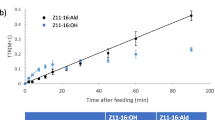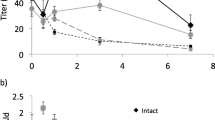Abstract
The trienoic and tetraenoic polyenes, (3Z,6Z,9Z)-3,6,9-nonadecatriene, (3Z,6Z,9Z)-3,6,9-henicosatriene, and (3Z,6Z,9Z)-1,3,6,9-henicosatetraene were found in the abdominal cuticle and pheromone gland of the winter moth Operophtera brumata L. (Lepidoptera: Geometridae), in addition to the previously identified single component sex pheromone (3Z,6Z,9Z)-1,3,6,9-nonadecatetraene. The pheromone biosynthesis activating neuropeptide (PBAN) is involved in the regulation of polyene transport from abdominal cuticle to the pheromone gland. In vivo deuterium labeling experiments showed that (11Z,14Z,17Z)-11,14,17-icosatrienoic acid, the malonate elongation product of linolenic acid, (9Z,12Z,15Z)-9,12,15-octadecatrienoic acid, is used to produce (3Z,6Z,9Z)-3,6,9-nonadecatriene and (3Z,6Z,9Z)-1,3,6,9-nonadecatetraene.





Similar content being viewed by others
References
Ando T, Ohtani K, Yamamoto M, Miyamoto T, Qin X-R, Witjaksono (1997) Sex pheromone of Japanese giant looper, Ascotis selenaria cretacea: identification and field tests. J Chem Ecol 23:2413–2423
Bestmann HJ, Borsche T, Koschatzky KH, Michaelis K, Platz H, Roth K, Suess J, Vostrosky O, Knauf W (1982) Pheromones XLII. 1,3,6,9-nonadecatetraene, the sex pheromone of the winter moth Operophtera brumata Geometridae. Tetrahedron Lett 23:4007–4010
Carrow GM, Calabrese RL, Williams CM (1981) Spontaneous and evoked release of prothoracicotropin from multiple neurohemal organs of the tobacco hornworm. Proc Natl Acad Sci U S A 78:5866–5870
Choi M-Y, Lim H, Park KC, Adlof R, Wang S, Zhang A, Jurenka R (2007) Identification and biosynthetic studies of the hydrocarbon sex pheromone in Utetheisa ornatrix. J Chem Ecol 33:1336–1345
Chu AJ, Blomquist GJ (1979) Decarbxylation of tetracosanoic acid to n-tricosane in the termite Zootermopsis angusticollis. Comp Biochem Physiol 66B:313–317
Conner WE, Eisner T, Meer RKV, Guerrero A, Ghiringelli D, Meinwald J (1980) Sex attractant of an arctiid moth (Utetheisa ornatrix): a pulsed chemical signal. Behav Ecol Sociobiol 7:55–63
Ding B-J, Liénard MA, Wang H-L, Zhao C-H, Löfstedt C (2011) Terminal fatty-acyl-CoA desaturase involved in sex pheromone biosynthesis in the winter moth (Operophtera brumata). Insect Biochem Mol Biol 41:715–722
Goller S, Szöcs G, Francke W, Schulz S (2007) Biosynthesis of (3Z,6Z,9Z)-3,6,9-octadecatriene: the main component of the pheromone blend of Erannis bajaria. J Chem Ecol 33:1505–1509
Howard RW, Blomquist GJ (1982) Chemical ecology and biochemistry of insect hydrocarbons. Annu Rev Entomol 27:149–172
Howard RW, Blomquist GJ (2005) Ecology, behavioral and biochemical aspects of insect hydrocarbons. Annu Rev Entomol 50:371–393
Heath RR, Tumlinson JH, Leppla NC, McLaughlin JR, Dueben B, Dundulis E, Guy RH (1983) Identification of a sex pheromone produced by female velvetbean caterpillar moth. J Chem Ecol 9:645–656
Jain SC, Dussourd DE, Conner WE, Eisner T, Guerrero A, Meinwald J (1983) Polyene pheromone components from an arctiid moth (Utetheisa ornatrix): characterization and synthesis. J Org Chem 48:2266–2270
Jurenka RA, Subchev M, Abad J-L, Choi M-Y, Fabrias G (2003) Sex pheromone biosynthetic pathway for disparlure in the gypsy moth, Lymantria dispar. Proc Natl Acad Sci U S A 100:809–814
MacPhee AW (1967) The winter moth, Operophtera brumata (Lepidoptera: Geometridae), a new pest attacking apple orchards in Nova Scotia, and its cold hardiness. Can Entomol 99:829–834
Major MA, Blomquist GJ (1978) Biosynthesis of hydrocarbons in insects: decarboxylation of long chain acids to n-alkanes in Periplaneta. Lipids 13:323–328
Matsuoka K, Tabunoki H, Kawai T, Ishikawa S, Yamamoto M, Sato R, Ando T (2006) Transport of a hydrophobic biosynthetic precursor by lipophorin in the hemolymph of a geometrid female moth which secretes an epoxyalkenyl sex pheromone. Insect Biochem Mol Biol 36:576–583
Millar JG (2000) Polyene hydrocarbons and epoxides: a second major class of Lepidopteran sex attractant pheromones. Annu Rev Entomol 45:575–604
Qiu Y, Tittiger C, Wicker-Thomas C, Le Goff G, Young S, Wajnberg E, Fricaux T, Taquet N, Blomquist GJ, Feyereisen R (2012) An insect-specific P450 oxidative decarbonylase for cuticular hydrocarbon biosynthesis. Proc Natl Acad Sci U S A 109:14858–14863
Reed JR, Vanderwel D, Choi S, Pomonis JG, Reitz RC, Blomquist GJ (1994) Unusual mechanism of hydrocarbon formation in the housefly: cytochrome P450 converts aldehyde to the sex pheromone component (Z)-9 tricosene and CO2. Proc Natl Acad Sci U S A 91:10000–10004
Reed JR, Quilici DR, Blomquist GJ, Reitz RC (1995) Proposed mechanism for the cytochrome(c) P450 catalyzed conversion of aldehydes to hydrocarbons in the housefly, Musca domestica. Biochemistry 34:26221–26227
Roelofs WL, Hill AS, Linn CE, Meinwald J, Jain SC, Herbert HJ, Smith RF (1982) Sex pheromone of the winter moth, a geometrid with unusually low temperature precopulatory responses. Science 217:657–659
Schal C, Sevala V, Carde RT (1998a) Novel and highly specific transport of a volatile sex pheromone by hemolymph lipophorin in moths. Naturwissenschaften 85:339–342
Schal C, Sevala VL, Young HP, Bachmann JAS (1998b) Sites of synthesis and transport pathways of insect hydrocarbons: cuticle and ovary as target tissues. Am Zool 38:382–393
Szöcs G, Tóth M, Karpati Z, Zhu JW, Löfstedt C, Plass E, Francke W (2004) Identification of polyenic hydrocarbons from the northern winter moth, Operophtera fagata, anddevelopment of a species specific lure for pheromone traps. Chemecology 14:53–58
Underhill EW, Palaniswamy P, Abrams SR, Bailey BK, Steck WF, Chisholm MD (1983) Triunsaturated hydrocarbons, sex pheromone components of Caenurgina erechtea. J Chem Ecol 9:1413–1423
Wang H-L, Zhao C-H, Millar JG, Carde RT, Löfstedt C (2010) Biosynthesis of unusual moth pheromone components involves two different pathways in the navel orangeworm, Amyelois transitella. J Chem Ecol 36:535–547
Wei W, Miyamoto T, Endo M, Murakawa T, Pu GQ, Ando T (2003) Polyunsaturated hydrocarbons in the hemolymph: biosynthetic precursors of epoxy pheromones of geometrid and arctiid moths. Insect Biochem Mol Biol 33:397–405
Wei W, Yamamoto M, Asato T, Fujii T, Pu G-Q, Ando T (2004) Selectivity and neuroendocrine regulation of the precursor uptake by pheromone glands from hemolymph in geometrid female moths, which secrete epoxyalkenyl sex pheromones. Insect Biochem Mol Biol 34:1215–1224
Witjaksono, Ohtani K, Yamamoto M, Miyamoto T, Ando T (1999) Responses of Japanese giant looper male moth to synthetic sex pheromone and related compounds. J Chem Ecol 25:1633–1642
Witte V, Foitzik S, Hashim R, Maschwitz U, Schulz S (2009) Fine tuning of social integration by two myrmecophiles of the ponerine army ant, Leptogenys distinguenda. J Chem Ecol 35:355–367
Acknowledgments
We thank Dr. Wittko Francke, Institute of Organic Chemistry, University of Hamburg, for providing the triene and tetraene reference compounds; Dr. Jocelyn G. Millar, Department of Entomology, University of California Riverside, for his long-term support and discussion on this study; and Dr. Richard Newcomb, School of Biological Sciences, University of Auckland, for comments on the manuscript. This study was supported by grants from the Swedish Research Council (VR) and SIDA-Sarec to CL.
Author information
Authors and Affiliations
Corresponding author
Additional information
Deceased May 1st 2011 in the course of this study. The other authors dedicate the publication to the memory of Prof. Cheng-Hua Zhao and his contributions to chemical ecology.
Electronic supplementary material
Below is the link to the electronic supplementary material.
ESM 1
(DOCX 19 kb)
Rights and permissions
About this article
Cite this article
Wang, HL., Zhao, CH., Szöcs, G. et al. Biosynthesis and PBAN-Regulated Transport of Pheromone Polyenes in the Winter Moth, Operophtera brumata . J Chem Ecol 39, 790–796 (2013). https://doi.org/10.1007/s10886-013-0292-1
Received:
Revised:
Accepted:
Published:
Issue Date:
DOI: https://doi.org/10.1007/s10886-013-0292-1




